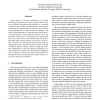118 search results - page 20 / 24 » Why computerized models to control virtual Humans |
VRML
2004
ACM
14 years 1 months ago
2004
ACM
Increasingly, biology researchers and medical practitioners are using computational tools to model and analyze dynamic systems across scales from the macro to the cellular to the ...
HICSS
2008
IEEE
14 years 2 months ago
2008
IEEE
In this paper we describe mechanisms for execution monitoring of semantic web services, based on OWL-S. The use of semantic descriptions and ontologies is a valuable extension to ...
EVOW
2010
Springer
14 years 2 months ago
2010
Springer
A relatively rare application of artificial intelligence at the nexus of art and music is dance. The impulse shared by all humans to express ourselves through dance represents a u...
VRST
2003
ACM
14 years 26 days ago
2003
ACM
Trimmed NURBS surfaces are often used to model smooth and complex objects. Unfortunately, most existing hardware graphics accelerators cannot render them directly. Although there ...
ATAL
2006
Springer
13 years 11 months ago
2006
Springer
Affective reasoning plays an increasingly important role in cognitive accounts of social interaction. Humans continuously assess one another's situational context, modify the...


